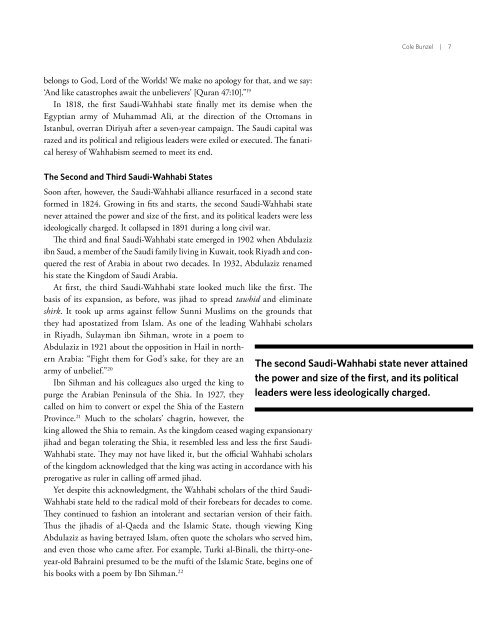Create successful ePaper yourself
Turn your PDF publications into a flip-book with our unique Google optimized e-Paper software.
Cole Bunzel | 7<br />
belongs to God, Lord of the Worlds! We make no apology for that, and we say:<br />
‘And like catastrophes await the unbelievers’ [Quran 47:10].” 19<br />
In 1818, the first Saudi-Wahhabi state finally met its demise when the<br />
Egyptian army of Muhammad Ali, at the direction of the Ottomans in<br />
Istanbul, overran Diriyah after a seven-year campaign. The Saudi capital was<br />
razed and its political and religious leaders were exiled or executed. The fanatical<br />
heresy of Wahhabism seemed to meet its end.<br />
The Second and Third Saudi-Wahhabi States<br />
Soon after, however, the Saudi-Wahhabi alliance resurfaced in a second state<br />
formed in 1824. Growing in fits and starts, the second Saudi-Wahhabi state<br />
never attained the power and size of the first, and its political leaders were less<br />
ideologically charged. It collapsed in 1891 during a long civil war.<br />
The third and final Saudi-Wahhabi state emerged in 1902 when Abdulaziz<br />
ibn Saud, a member of the Saudi family living in Kuwait, took Riyadh and conquered<br />
the rest of Arabia in about two decades. In 1932, Abdulaziz renamed<br />
his state the Kingdom of Saudi Arabia.<br />
At first, the third Saudi-Wahhabi state looked much like the first. The<br />
basis of its expansion, as before, was jihad to spread tawhid and eliminate<br />
shirk. It took up arms against fellow Sunni Muslims on the grounds that<br />
they had apostatized from Islam. As one of the leading Wahhabi scholars<br />
in Riyadh, Sulayman ibn Sihman, wrote in a poem to<br />
Abdulaziz in 1921 about the opposition in Hail in northern<br />
Arabia: “Fight them for God’s sake, for they are an<br />
The second Saudi-Wahhabi state never attained<br />
army of unbelief.” 20<br />
Ibn Sihman and his colleagues also urged the king to the power and size of the first, and its political<br />
purge the Arabian Peninsula of the Shia. In 1927, they leaders were less ideologically charged.<br />
called on him to convert or expel the Shia of the Eastern<br />
Province. 21 Much to the scholars’ chagrin, however, the<br />
king allowed the Shia to remain. As the kingdom ceased waging expansionary<br />
jihad and began tolerating the Shia, it resembled less and less the first Saudi-<br />
Wahhabi state. They may not have liked it, but the official Wahhabi scholars<br />
of the kingdom acknowledged that the king was acting in accordance with his<br />
prerogative as ruler in calling off armed jihad.<br />
Yet despite this acknowledgment, the Wahhabi scholars of the third Saudi-<br />
Wahhabi state held to the radical mold of their forebears for decades to come.<br />
They continued to fashion an intolerant and sectarian version of their faith.<br />
Thus the jihadis of al-Qaeda and the Islamic State, though viewing King<br />
Abdulaziz as having betrayed Islam, often quote the scholars who served him,<br />
and even those who came after. For example, Turki al-Binali, the thirty-oneyear-old<br />
Bahraini presumed to be the mufti of the Islamic State, begins one of<br />
his books with a poem by Ibn Sihman. 22



